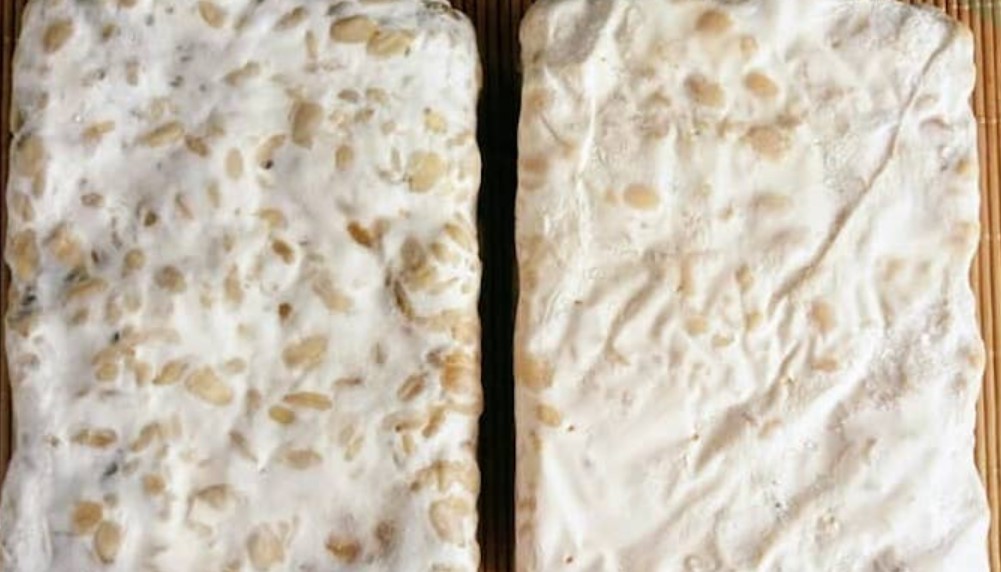Tempeh is a traditional fermented product made from soybeans and has been eaten in Indonesia for centuries. The meat substitute is now also popular in Europe. Here you will find an overview of the healthy soy product.
Tempeh is a fermentation product made from whole soybeans, water, vinegar and mold. The meat substitute originated in Indonesia. Tempeh is still an important staple there today, helping to meet the protein needs of the population. Today you can also buy tempeh in Germany. The soy product is particularly popular in vegan cuisine.
Thanks to the high content of valuable nutrients, proteins and fiber, tempeh is also very healthy. This means that the soy product is not only suitable as a meat substitute for vegans and vegetarians, but is also interesting for everyone who pays attention to a balanced diet.
Tempeh tastes very mild and has a slightly nutty-mushroom aroma. It is therefore advisable to season the meat substitute well, as it has little taste of its own.
How is tempeh made?

You don’t necessarily have to buy the fermented soy product. Instead, you can make your own tempeh. You need whole soybeans for this. These should be soaked, boiled and provided with mold spores (usually Rhizopus cultures). The soybeans then ferment for 24 to 48 hours in a closed container at around 30 degrees Celsius. The molds form thread-like white cells that wrap themselves around the soybeans and hold them together after fermentation. This creates solid blocks of tempeh that are easy to cut.
You can find tempeh sealed airtight in organic markets, health food stores, Asian markets or in well-stocked supermarkets. Blocks of tempeh from the refrigerated section usually keep for several weeks. Once opened, however, you should use the product within a few days. Tempeh from the jar has a much longer shelf life and can be stored unopened for several months.
By the way: In addition to traditional tempeh made from soybeans, there is now also tempeh made from other legumes, such as lupins or black beans.
Tempeh: The meat alternative is so healthy
A look at the nutrient composition of tempeh explains why the meat substitute is becoming increasingly popular with us: With around 20 grams of protein per 100 grams, tempeh is a real protein bomb, contains few carbohydrates and fat and is a low-calorie filler. Tempeh is a valuable vegetable protein source, especially for people who eat vegetarian or vegan food.
The protein content is even higher than that of tofu and the protein it contains can be absorbed particularly well by the body thanks to the fermentation process. In addition, the fermentation makes the gluten-free soybeans more digestible. Unlike animal protein, tempeh also contains no cholesterol. Tempeh also provides a variety of minerals, including iron, calcium and phosphorus.
The organic tempeh from the tempeh manufactory contains the following nutritional values, for example:
Calories: 152 calories
Egg white: 18.95 g
Fat: 7.68g
Fiber: 6.5 g
Carbohydrates: 1.8g
Tempeh: It depends on the preparation
Traditionally, you can slice tempeh and sear or fry it. But the meat substitute also tastes good raw, smoked, grilled or cooked. Tempeh works well as a side dish in salads, soups, vegan schnitzel or sandwiches. You can also process tempeh in other ways as you wish and use it for vegan goulash or vegan bolognese, for example.
You can also buy tempeh marinated with various spices and herbs. Alternatively, you can put the tempeh in a spicy marinade yourself before preparing it.
How sustainable is the meat substitute?

In contrast to meat, meat substitute products have a significantly better ecological balance, including tempeh and tofu. You can find out more about this topic here: Study: Plant-based meat substitutes have a better ecological balance
This is mainly due to the fact that significantly fewer resources are required for soy production than is the case for the production of meat. In particular, large-scale monocultures, which farmers need for the production of feed soy, are highly problematic from an ecological point of view. After all, corporations often cut down large areas of rainforest for this purpose. Added to this is the large water consumption and significant greenhouse gas emissions associated with livestock farming.
So that your tempeh is particularly sustainable, you should pay attention to regional products when buying it. You can now also find tempeh with soybeans from European cultivation. Also use organic products whenever possible. This is how you avoid chemical-synthetic pesticides and genetically modified soybeans.


You made a number of nice points there. I did a search on the matter and found nearly all persons will have the same opinion with your blog… Have you considered promoting your blog? add it to SEO Directory right now 🙂
Hi 🙂 Thank you for the auspicious writeup. It if truth be told was a enjoyment account it. Glance complicated to far introduced agreeable from you! However, how could we keep in touch?